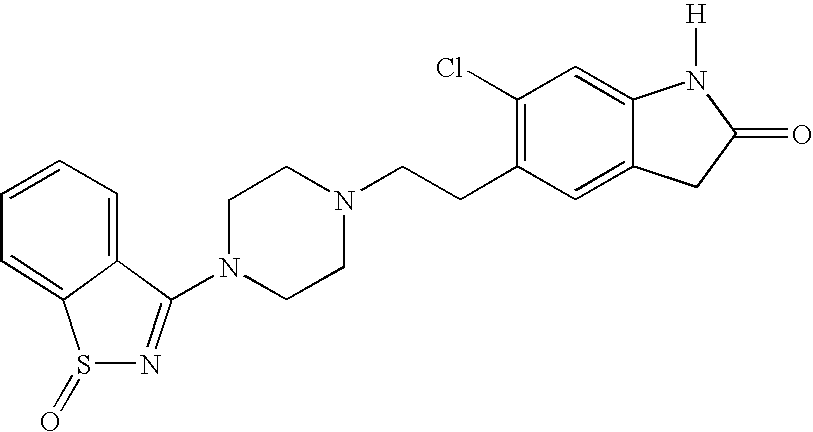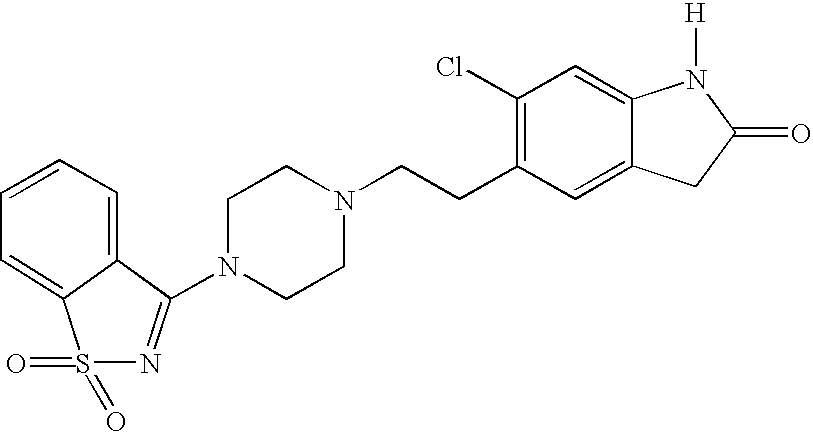Methods and compositions for the treatment of neuroleptic and related disorders using ziprasidone metabolites
- Summary
- Abstract
- Description
- Claims
- Application Information
AI Technical Summary
Benefits of technology
Problems solved by technology
Method used
Image
Examples
example 1
5.1. Example 1
Synthesis of Ziprasidone
[0056] To a 125 mL round bottom flask equipped with an N2 inlet and condenser are added 0.73 g (3.2 mmol) 5-(2-chloroethyl)-6-chloro-oxindole, 0.70 g (3.2 mmol) N-(1,2-benzisothiazol-3-yl)piperazine, 0.68 g (6.4 mmol) sodium carbonate, 2 mg sodium iodide, and 30 mL methylisobutyl ketone. The reaction is refluxed for 40 hours, cooled, filtered, and evaporated. The residue is chromatographed on silica gel, eluting the by-products with ethyl acetate (1 L) and the product with 4% methanol in ethyl acetate (1.5 L). The product fractions (Rf=0.2 in 5% methanol in ethyl acetate) are evaporated, taken up in methylene chloride, and precipitated by addition of ether saturated with HCl; the solid is filtered and washed with ether, dried, and washed with acetone. The latter is done by slurrying the solid with acetone and filtering. Ziprasidone is obtained as a high melting, non-hygroscopic solid product having an expected melting point of 288° C. to 288.5°...
example 2
5.2. Example 2
Synthesis of Ziprasidone Sulfoxide
[0057] To a solution of ziprasidone made as described in Example 1 (0.70 g, 1.7 mmol) in acetonitrile is added 30% H2O2 (1.7 mmol). After stirring for 24 hours at room temperature, the reaction mixture is cooled, filtered, and evaporated. The residue is chromatographed on silica gel, eluting the by-products with ethyl acetate (1 L) and the product with 4% methanol in ethyl acetate (1.5 L). The product fractions are evaporated, taken up in methylene chloride, and precipitated by addition of ether saturated with HCl; the solid is filtered and washed with ether, dried, and washed with acetone.
example 3
5.3. Example 3
Synthesis of Ziprasidone Sulfone
[0058] To a solution of ziprasidone sulfoxide made as described in Example 2 (0.76 g, 1.7 mmol) in acetonitrile is added 30% H2O2 (1.7 mmol). After stirring for 24 hours at room temperature, the reaction mixture is cooled, filtered, and evaporated. The residue is chromatographed on silica gel, eluting the by-products with ethyl acetate (1 L) and the product with 4% methanol in ethyl acetate (1.5 L). The product fractions are evaporated, taken up in methylene chloride, and precipitated by addition of ether saturated with HCl; the solid is filtered and washed with ether, dried, and washed with acetone.
[0059] Alternatively, ziprasidone sulfone may be obtained by one step oxidation of ziprasidone. To a solution of ziprasidone made as described in Example 1 (0.70 g, 1.7 mmol) in acetonitrile is added 30% H2O2 (3.4 mmol). After stirring for 24 hours at room temperature, the reaction mixture is cooled, filtered, and evaporated. The residue is...
PUM
 Login to View More
Login to View More Abstract
Description
Claims
Application Information
 Login to View More
Login to View More - R&D
- Intellectual Property
- Life Sciences
- Materials
- Tech Scout
- Unparalleled Data Quality
- Higher Quality Content
- 60% Fewer Hallucinations
Browse by: Latest US Patents, China's latest patents, Technical Efficacy Thesaurus, Application Domain, Technology Topic, Popular Technical Reports.
© 2025 PatSnap. All rights reserved.Legal|Privacy policy|Modern Slavery Act Transparency Statement|Sitemap|About US| Contact US: help@patsnap.com



